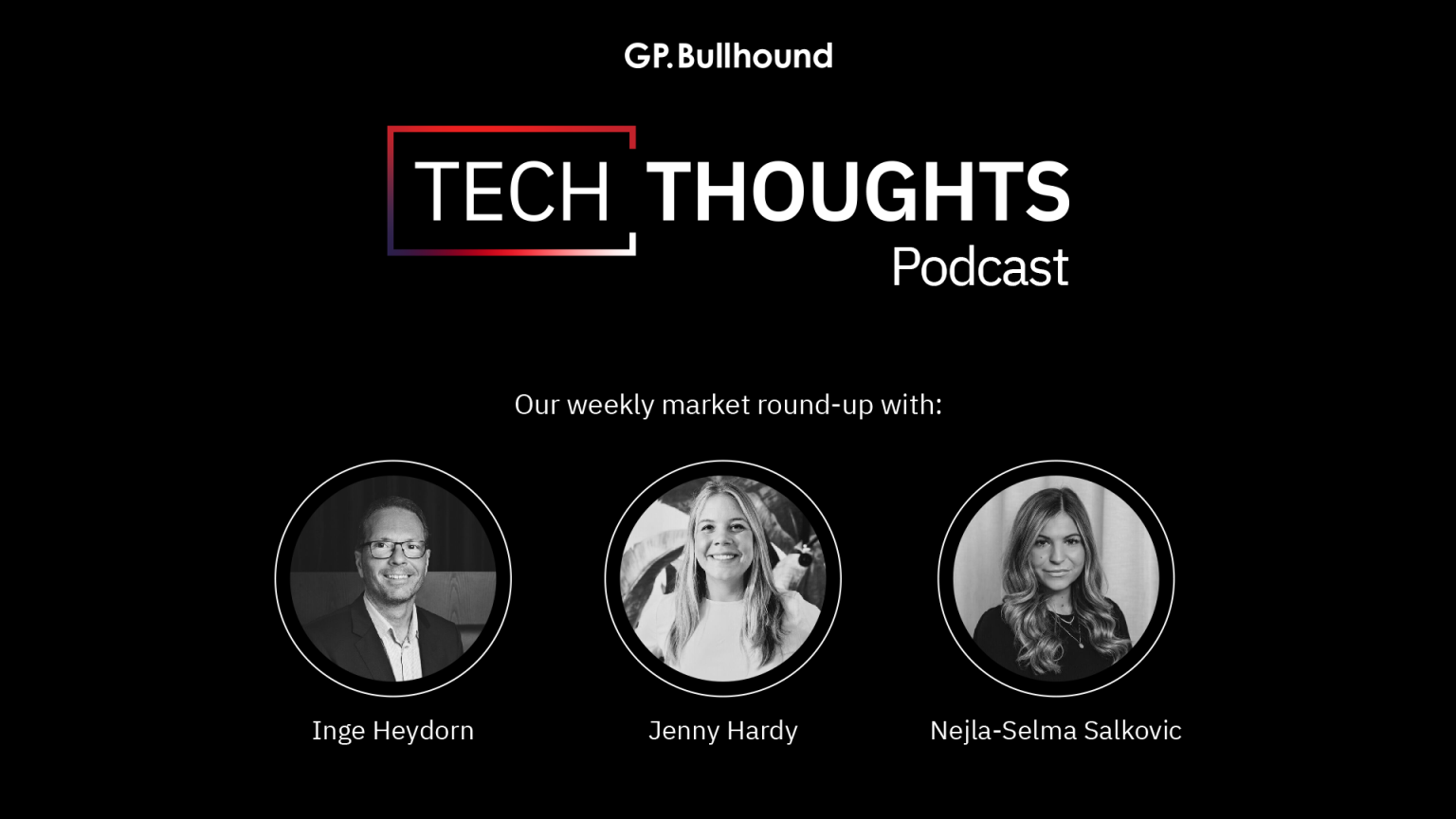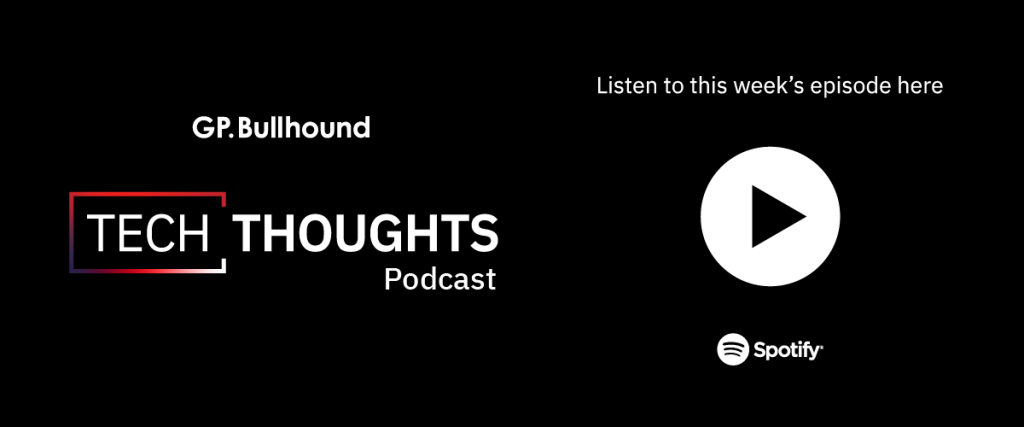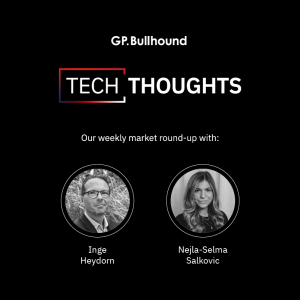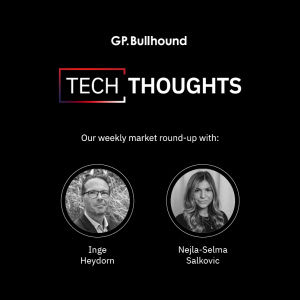Tech Thoughts Newsletter – 19 May 2023.

Market: Technology continues to perform strongly and especially relative to the market driven by lower interest rates, cost-cutting and a focus on AI. The positive tone around the debt ceiling negotiations is also helpful.
Portfolio: We have not made any major changes in our portfolio this week
Firstly, some thoughts on streaming, TV and market share shifts. Nielsen data was out for April, which we think is worth taking a closer look into, and the streaming/TV market was in our minds after Disney’s reporting last week.
There’s no surprise that cord-cutting is continuing apace (and indeed – we saw that with Disney last week and their linear TV business – where affiliate growth tipped negative as cord-cutting outpaced rate increases).
Comparing April 2023 numbers with a year prior, we have Cable’s share of TV losing over 5ppts share from 37% to 32% of time spent, and Streaming – no surprise, gaining 4ppts – going from 30% to 34%.
What’s interesting for us is what’s happening within the Streaming market. YouTube’s high and increasing market share – stands out in this set of numbers. According to Nielsen the top streaming platforms by share of time spent viewing were: YouTube (8.1%), Netflix (6.9%), Hulu (3.3%), Amazon Prime (2.8%), Disney+ (1.8%), HBO Max (1.2%). YouTube was the only meaningful gainer in market share -200bps share gains from a year ago. The other share gains were pretty incremental: Netflix gained 30bps, Disney 10bps, Prime 30bps; the long tail of smaller streaming platforms lost (no surprise there – content is a scale game..)..
These numbers exclude YouTube TV’s subscription business (which is more like a traditional linear TV business – but is bucking the linear trend and growing subscribers.)
It’s interesting because although YouTube comes from a completely different business model (free, ads-first) and UGC content vs produced, it is really the biggest key competitor for Netflix and Disney. What matters for all of them – particularly where streaming business models are moving towards advertising – is eyeballs.
For now, cable decline is lifting all streaming boats. But YouTube’s increasing dominance will be more notable once that cable tailwind shift to streaming goes away.
For us in the portfolio, we’re still sceptical about the long-term returns in streaming, and it’s hard not to view the presence of Amazon, Apple, and YouTube as a negative to the path to profitability and the sustainable level of profitability.
Elsewhere, rumours are rife that Apple will launch its mixed-reality AR headset next month at its annual WWDC event. The headset will supposedly resemble ski goggles with an external battery pack. The rumoured price is $3,000..
We still don’t know what the chipset looks like – whether it will be dual M2 chips (one for each eye?!) on TSMC 4/5nm, or two M1 Max (at a previous 5nm TSMC node).
There are lots of debates around this and, indeed some differing views within our own team around whether the headset could be the next hardware platform shift…
$3000 is a lot for an entertainment-only device, but it’s not that hard to imagine a headset as a work device – virtual meetings, multiple screens.. The PC, after all, was originally principally bought by employers for their employees to increase productivity..
We’re not putting any expectations on the headset as “the next iPhone”, and think of it for now as a high-priced, earlier adopter product.. But maybe in 10 years time, we’ll all be walking the streets with our ski goggles on..
Applied Materials showing spending continues at the trailing edge.
- AMAT (owned) beat the quarter and guided ahead. Their ICAPS (IoT, Comms, Auto, Power and Sensors – effectively trailing edge) business is getting stronger – and they specifically called out regions outside of China – US, Europe and Japan – as also driving growth driven by the geopolitical incentives (we saw more announcements in Japan this week – more on that below).
- It’s important because the market is starting to question how sustainable the spend in China is (China is still the largest geography within their ICAPS business)
- They spoke very confidently about the China demand – they say they can see the equipment being installed and ramped and utilisation being healthy (so that these aren’t just machines being bought and stashed by the Chinese in case export rules get more stringent)
- ICAPS strength more than offsetting the weaker memory demand (which, as per LAM, sounds like it can’t go much lower – it sounds like they agree, although don’t see an inflection yet)
- Aside from ASML (which is being separately supported by EUV adoption), AMAT should probably defend revenue the best in the current market downturn, given early investment in, and over exposure to, the trailing edge ICAPS business.
- $2.3bn cash flow in the quarter – reflects what we’ve seen across semicap reporting
Portfolio view – we’re reassured that semicap spending in China is meeting real demand. Relatedly this week, Analog Devices (owned) announced a new investment €630m investment in a new fab in Limerick. Specifically called out drivers of an increased need for capacity is electric vehicles and robotics, which supports our conviction around auto semis.
Japanese strategic semiconductor investments
- Japan was once a semiconductor powerhouse (now it still has strong positions in wafer manufacturing and passive components) but it missed the PC and smartphone boom and fell behind.
- Like US and Europe, Japan too is now putting lots of investment around building up their own localised supply.
- This week, Japanese prime minister Fumio Kishida met the heads of chipmakers, including TSMC, Samsung Electronics and Intel and Micron.
- Micron said it expected to invest up to Y500bn ($3.7bn), including Japanese state subsidies, to build a plant to produce cutting-edge extreme ultraviolet (EUV) – lithography technology in Hiroshima.
- Samsung is also discussing setting up a Y30bn research and development centre in Yokohama with pilot lines for semiconductor devices.
- Kyocera (Japanese supplier) also announced it would invest $3bn in capacity to meet AI demand.
Portfolio view: supportive for all of the semicap equipment space – and indeed AMAT called out Japan as being a region driving demand in its ICAPS business. Micron would be Japan’s first EUV (ASML) chip-making facility. Worth saying on ASML as well that this week TSMC announced that they are now moving in EUV tools into their Arizona fab, ready for N4 production in 2024.
Software and the AI enterprise opportunity
- ServiceNow (owned) hosted a capital markets day on Tuesday giving the market a slew of new forecasts and announcing its first buy back program (as we’ve seen from lots of tech so far this year, in the same vein as cost-cutting..) The buy back program totaled $1.5bn and the primary objective of the buyback is to manage the impact of dilution from future employee equity grants and employee stock purchase programs (again, we’re seeing software companies somewhat “get religion” around high share based compensation costs).
- On the guidance side, the company lowered its long term subscription target next year to $10.4bn from $11bn and $15bn in 2026 from $16bn previously. Operating margin targets were, however raised 100bps.
- Their AI strategy was (of course) the order of the day – lots of new modules highlighted, including NOW Assist, connectors within the platform to general purpose AI models of hyper scalers/3rd parties, as well as domain specific LLMs where NOW will take 3rd party domain LLMs (e.g. Hugging Face and Nvidia), train them on a ServiceNow specific data, and make these solutions available to customers through the NOW marketplace.
- NOW also announced Cloud Observability, Generative AI Controller (integrate w/ MSFT & Open AI); NOW Assist for AI aided Search, AI-Powered (enhanced) Finance and Supply Chain Workflows, AI-powered Talent Transformation and G2K acq (connect real-time data across storefronts and other physical spaces, giving businesses a complete view of operational data).
Portfolio view: The financial changes were very much in line with expectations – there is no surprise that businesses who put out long-term guidance over the 2020/2021 period are now having to adjust given the cyclical slowdown. Their strong AI offering will definitely put the company at an even stronger relative position versus its competitors. It reflects what we think more broadly on enterprise software, that platform-leaders (We also own Salesforce, Microsoft, Workday, Palo Alto) have an increased ARPU opportunity around upselling premium AI features to large, sticky installed base.
SAP Sapphire – profit and FCF going in the wrong direction
- SAP (not owned) held their Sapphire event and tweaked up their revenue guide, but for us there wasn’t a huge amount of profit growth to get excited about..
- The problem for SAP is that its higher cloud revenue isn’t coming with higher cloud gross profit because their private infrastructure cost is going higher.
- The main positive is a slower decline in maintenance revenue from its legacy licence business (where philosophically, legacy business is clients not wanting to shift to cloud – against SAP’s strategy), all of that “benefit” is being negated by higher opex costs.
- For us it’s going in the opposite direction from the broader software space, which is seeing margin upside from a lower cost base and gross margin leverage from their cloud businesses.. FCF was also downgraded, again, counter to we’re happily seeing from lots of our holdings
EV trend continues, driven by extraordinarily strong China numbers
- China average daily retail sales of passenger cars between May 1 – 14 reached 706,000 units, up 55% y/y, up 24% m/m, and EV retail sales at 217k units in first two weeks of May, +101% YoY / +17% MoM. EV market share has grown to around 50% in top tier cities in China.
- There continue to be significant market share shifts involving the Chinese EV players, which seems to be driving brands to increase more and more content. Geely’s Zeekr 001, which is the first 1000km range vehicle, launched in China this week
Portfolio view: This war for content and differentiation and range and performance is also very good for semiconductor content. And auto semis, unlike auto OEMs, have pricing power, which means we’re seeing margin upgrades (vs Tesla’s – which we don’t own – margin downgrades). It reminded us a bit of Toyota’s CTO comments on their earnings call last week:
“As you said, we went to the Shanghai Motor Show, frankly, I was totally amazed basically the electrification of battery EV was progressing very rapidly, not only that, but that’s already taken for granted and that differentiation and competition over differentiating through adding intelligence was much faster than we expected.”
Gaming a mixed picture – 2023 still tough – longer term hope that new hardware and software releases will drive market demand
- Overall US spending on video games in April was down 5% y/y from $4.32 billion to $4.12 billion. Spending on video game content decreased six percent from $3.82 billion to $3.60 billion, while video game hardware sales jumped seven percent from $343 million to $367 million.
- Overall spending on video games in 2023 year-to-date is down 2% from $18.11 billion to $17.71 billion. Spending on video game content decreased four percent from $15.79 billion to $15.11 billion, while video game hardware sales is up 18 percent from $1.55 billion to $1.82 billion
- Star Wars Jedi: Survivor debuted at the top of the software charts (ranked by dollar sales) and is the fourth best-selling game of 2023. The game was only available in two days of tracking on the April charts. Dead Island 2 debuted in second place and is the sixth best-selling game of 2023. PGA Tour debuted in seventh place, Mega Man Battle Network Legacy Collection debuted in eighth, Minecraft Legends debuted in 11th, Final Fantasy I-VI Bundle debuted in 14th, and Advance Wars 1+2: Re-Boot Camp debuted in 15th.
- The Nintendo Switch was the best-selling console in the US in April 2023 in terms of units sold, The Nintendo Switch – OLED Model The Legend of Zelda: Tears of the Kingdom Edition released at the end of April and helped boost the sales of the console.
- In terms of dollar sales, the PlayStation 5 was number one, followed by the Nintendo Switch in second place, and the Xbox Series X|S is in third.
- TakeTwo (not owned) reported a 4Q slightly ahead of expectations and guided financial 2024 below expectations. 2024 is expected to be negatively affected by weaker consumer spending and a number of delayed releases and some cancellations of games.
- The company is however taking a very positive stance towards 2025, expecting bookings to grow to $8bn driven by new releases. Will this include the new GTA? The company also stated that the operating result will grow in 2026 from 2025.
- Nintendo (owned) announced that The Legend of Zelda: Tears of the Kingdom has sold over 10 million units worldwide in its first three days available. This matches what Pokémon Scarlet and Violet sold in its first three days last November. The biggest release ever for the Zelda franchise. Sales includes over four million units sold in the Americas, which is the fastest selling Switch game and Nintendo game for any platform in that region. The game also sold 2.24 million units in Japan.
- See above US gaming sales April, that the Zelda game is helping Nintendo to increase their sales of Switch consoles.
Portfolio view – We continue to believe that Nintendo has a very strong position in the market and has a very strong fan base. We are now awaiting the new console from the company that most likely will be released during 2024.

For weekly insights on the latest market updates, please subscribe to our Tech Thoughts podcast.
For more information about the latest trends and forecasts, please visit our official Tech Thoughts page.
We provide investors with access to category leading technology companies, globally. Our assets under management have a total value of more than $1bn, and our limited partners include institutions, family offices and entrepreneurs. Learn more about our funds here.
Enquiries
For enquiries, please contact:
Inge Heydorn, Partner, at inge.heydorn@gpbullhound.com
Jenny Hardy, Portfolio Manager, at jenny.hardy@gpbullhound.com
Nejla-Selma Salkovic, Analyst, at nejla-selma.salkovic@gpbullhound.com
About GP Bullhound
GP Bullhound is a leading technology advisory and investment firm, providing transaction advice and capital to the world’s best entrepreneurs and founders. Founded in 1999 in London and Menlo Park, the firm today has 13 offices spanning Europe, the US and Asia. For more information, please visit www.gpbullhound.com.

